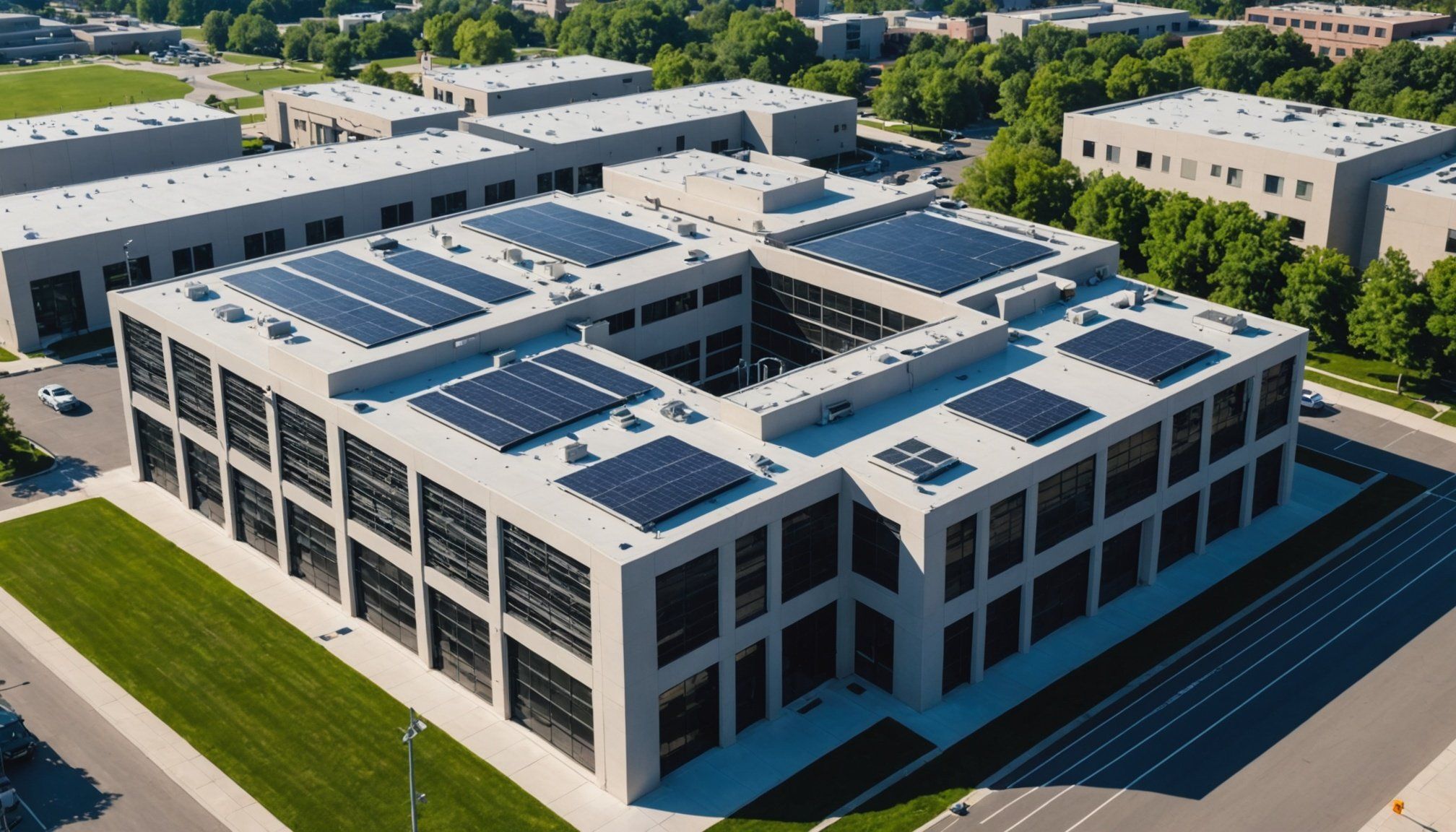Revolutionary HVAC Innovations: Advanced Energy Efficiency Solutions for Enhancing Large Building Performance
In the ever-evolving landscape of building management, Heating, Ventilation, and Air Conditioning (HVAC) systems have become a cornerstone of modern infrastructure. As the world grapples with the challenges of climate change and energy sustainability, innovative HVAC technologies are emerging to transform the way we manage energy efficiency in large buildings. Here, we delve into the cutting-edge solutions that are redefining the HVAC industry and paving the way for a more sustainable future.
The Evolution of HVAC Systems: From Basic to Smart
HVAC systems have come a long way from their basic heating and cooling functions. Today, these systems are integrated with advanced technologies that optimize energy efficiency, enhance comfort, and reduce environmental impact.
Also read : Exploring the UK Building Safety Act: What It Means for Future Development Projects
Smart HVAC Systems and IoT Integration
Modern HVAC systems are no longer standalone units; they are now part of a larger network of smart technologies. The integration of Internet of Things (IoT) and artificial intelligence (AI) has enabled these systems to adjust settings in real time, ensuring optimal comfort and energy savings.
For instance, connected HVAC systems use sensors and IoT technologies to automatically adjust settings, providing real-time monitoring and predictive maintenance. This not only enhances energy efficiency but also reduces the likelihood of system failures and improves overall performance[1].
Also to read : Unlocking the Legal Maze: Ultimate Guide to Transforming UK Agricultural Land into Residential Property
Grid-Interactive Efficient Buildings (GEBs): The Future of Energy Management
One of the most significant advancements in HVAC technology is the concept of Grid-Interactive Efficient Buildings (GEBs). GEBs are designed to interact dynamically with the power grid, adjusting energy consumption based on grid demands and available energy sources.
How GEBs Work
GEB-enabled HVAC systems can pre-cool or pre-heat spaces before peak demand times, reducing energy consumption during the most expensive and environmentally impactful periods. These systems can also draw energy from on-site battery storage or adjust setpoints to maintain comfortable temperatures with minimal energy use[2].
Example:
During a summer afternoon when grid demand is high, a GEB’s HVAC system might reduce cooling output or use energy from battery storage, thereby reducing strain on the grid and lowering energy costs.
Advanced Heating and Cooling Technologies
The heart of any HVAC system lies in its heating and cooling technologies. Recent innovations have introduced more efficient and sustainable solutions that are transforming the industry.
Next-Generation Heat Pumps
Heat pumps have long been a staple in HVAC systems, but the latest generation offers unprecedented efficiency. These modern heat pumps use renewable resources, low-impact refrigerants, and variable-speed compressors to achieve exceptionally high coefficients of performance (COP), often reaching 5.5. This results in significant energy savings and a reduced carbon footprint[1].
Case Study:
A century-old house in England installed a modern heat pump system and achieved a COP of 5.5, drastically reducing its energy consumption and carbon emissions.
Efficient Cooling Systems
Cooling systems are another critical component of HVAC setups. Advanced cooling technologies such as water-cooled chillers and cooling towers are highly efficient for large commercial applications. These systems circulate conditioned air throughout the building, ensuring consistent temperatures and a comfortable environment[4].
The Role of Artificial Intelligence in HVAC Optimization
Artificial intelligence (AI) is playing an increasingly central role in optimizing HVAC system performance. AI can process vast amounts of data to predict weather changes, adjust system parameters, and identify potential issues before they arise.
AI in Real-Time Energy Management
AI-enabled HVAC systems can predict meteorological changes and adjust settings accordingly, maintaining optimal comfort levels while minimizing energy use. This real-time management not only enhances energy efficiency but also extends the lifespan of the system by preventing unnecessary wear and tear[1].
Quote:
“AI has the capability to treat enormous volumes of data to optimize the efficiency of HVAC systems, needs, and even counter flaws, all without problems,” highlighting the transformative potential of AI in HVAC management.
Innovative Insulation Materials
Insulation is a crucial aspect of building energy efficiency, and recent innovations have introduced materials that offer superior thermal performance with reduced thickness.
Advanced Insulation Materials
Materials like aerogels, vacuum insulators, and phase-change materials are revolutionizing thermal insulation. These materials improve energy efficiency, manage water vapor, reduce thermal bridges, and enhance the durability of building structures compared to traditional insulation materials[1].
Comparison Table:
| Insulation Material | Thermal Resistance | Thickness | Durability | Environmental Impact |
|---|---|---|---|---|
| Aerogels | High | Low | High | Low |
| Vacuum Insulators | Very High | Very Low | High | Low |
| Phase-Change Materials | High | Low | High | Low |
| Traditional Insulation | Medium | Medium | Medium | Medium |
Types of Efficient HVAC Systems for Large Buildings
Choosing the right HVAC system for a large building is crucial for meeting heating, cooling, and ventilation needs efficiently.
Packaged Systems
Packaged systems are all-in-one solutions that include heating, cooling, and air-handling units in a single compact unit. These systems are ideal for small to medium-sized commercial spaces and offer easy installation, maintenance, and cost-effectiveness[4].
Advantages:
- Easy installation and maintenance
- Cost-effective
- Reduces indoor noise
Rooftop Units (RTUs)
Rooftop units are designed for larger commercial buildings and are installed on the roof to save valuable indoor space. They offer scalability, ease of access for maintenance, and robust performance year-round[4].
Advantages:
- Space efficiency
- Scalability
- Ease of access for maintenance
Variable Refrigerant Flow (VRF) Systems
VRF systems are among the most advanced commercial HVAC solutions, operating without ducts and using refrigerant to cool or heat individual zones within a building. They are ideal for multi-zone buildings and offer energy efficiency, customizable comfort, quiet operation, and heat recovery capabilities[4].
Advantages:
- Energy efficiency
- Customizable comfort
- Quiet operation
- Heat recovery
Practical Insights and Actionable Advice
Implementing these innovative HVAC solutions requires careful planning and consideration. Here are some practical insights and actionable advice:
Conduct a Building Assessment
Before selecting an HVAC system, conduct a thorough building assessment to determine the specific heating, cooling, and ventilation needs of your building.
Invest in Smart Thermostats
Smart thermostats can significantly reduce energy consumption by optimizing temperature settings based on occupancy and weather forecasts.
Use Renewable Energy Sources
Consider integrating renewable energy sources such as solar or wind power to reduce your building’s reliance on traditional energy sources.
Regular Maintenance
Regular maintenance is key to ensuring the longevity and efficiency of your HVAC system. Partner with a reliable HVAC service provider to schedule routine checks and repairs.
The HVAC industry is undergoing a significant transformation, driven by the need for sustainable and energy-efficient solutions. From smart HVAC systems and GEBs to advanced insulation materials and innovative heating and cooling technologies, these innovations are not only reducing energy consumption but also enhancing comfort and sustainability in large buildings.
As we move forward, embracing these technologies will be crucial for achieving our sustainability goals. By integrating AI, IoT, and renewable energy sources into our HVAC systems, we can create buildings that are not only efficient but also sustainable and comfortable for generations to come.
Quote:
“L’industrie du génie climatique évolue rapidement et adopte de nouvelles technologies afin d’améliorer la performance énergétique des bâtiments. En prenant en compte ces avancées, nous pouvons diminuer notre empreinte carbone tout en établissant des environnements plus confortables et durables,” highlighting the transformative potential of these innovations[1].
By adopting these revolutionary HVAC innovations, we can create a future where buildings are not just structures, but sustainable, efficient, and comfortable environments that support both human well-being and the health of our planet.











